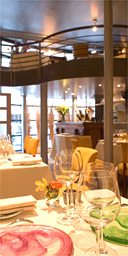
Telephone: +33 (0)1 4050 8440
Address: 4 Rue Beethoven, 75016 Paris
I eat out a lot. Because I cook for a living, on my days off I often just can't be bothered: salad and a pitta bread at a stretch (no stove required, you see). A mediocre biriyani from the local curry house will often taste much better than something I've just spent an hour preparing in the kitchen, even if I've made a special trip to M&S for their finest Himalayan yam blossom.
But I also eat out at a lot of top-end places, the gastrotemples, to which high exposure can soon lead to some pretty high standards. Obviously I don't expect any sympathy, in the same way that I can't offer any to a Ferrari test driver who has to work overtime, but the point remains. And when a restaurant opens its doors to the public and charges serious money for the food it serves, it can expect to be judged accordingly.
Unfortunately, forking out doesn't always mean forking good, and so many places are often either a bit too old fashioned, serving the same old fare to the same old guests, or a bit too ambitious ... anyone for lamb mousse with green tea jelly? So I'm delighted to be able to report on a restaurant that gets it pretty much spot on, at every level.
L'Astrance in Paris's 16th arrondissement only opened in 2000, but has already won two Michelin stars and received 19/20 in the last edition of GaultMillau. It's notably hard to get a table here, as it seats just 26, but it's definitely worth the effort. The dinner, costing €150, is surprise menu only. I simply told the waiters when they asked that I didn't much like kidneys (they take the piss), and then off we went. In total we had about 12 courses, though remembering them all afterwards proved to be a bit of a struggle. So here are the greatest hits.
The bread and butter were perfect: a nicely tangy sourdough with a proper crust and good-quality salted butter served at room temperature (not rocket science, but not as common as one might think). The amuse-bouches that followed - a shot glass of cardamom yoghurt, carrot puree, and mandarin foam - was light, vibrant and judiciously seasoned, and set the tone of what was to come.
A dish of roast endive with lime zest and spiced biscuit crumbs was another highlight, as was what appeared to be becoming the signature dish: a layered slice of foie gras marinated in verjus (a sour fruit juice) with raw button mushroom shavings and a blob of lemon purée. Both demonstrated a healthy regard for balance and invention. My favourite course was a rustic spoonful of apple clafoutis served with some crushed green apples to cut through the buttery cake; absolutely stunning. My least favourite, if forced to pick, was one of monkfish with pomelo fruit and shredded braised pork. There was nothing wrong with the execution; it was just my least favourite.
Throughout the meal, all the ingredients were precisely and often quite gently cooked, and seasoned with a light hand. The food was interesting without trying to be too cool. And though we were there in January (so many menus at this time can seem as dull as the weather), our meal still managed to burst with colour and freshness. Proceedings came to an end with fresh fruit (this may sound odd but worked very well in context), chestnut honey madeleines, and a fantastic eggnog, or "lait de poule".
In the same way as we put our faith in the chef, we did so with the sommelier. He sorted us out with a different wine for every one or two courses, and gave sensible amounts so we could appreciate them without finishing the meal half-cut. Again, too many to list - and, to be honest, too many to remember. The Sauternes with foie gras was lovely and not too sickly sweet; a crisp and nicely perfumed Riesling, served chilled, went well with the fish courses; and a glass of champagne was a great match with the endive.
For this standard of cooking in Paris, €300 for two, plus wine, is as good as it gets, and Pascal Barbot and Christophe Rohat, the chef and maitre d', undoubtedly deserve the success they are enjoying. Just to give you some context, at L'Arpège - the triple-Michelin starred restaurant in the 7th arrondissement where they both previously worked - a tasting menu will currently set you back €420 ... definitely something to chew on.
· Our chef reviewer has worked in Michelin-starred establishments in the UK, France and Spain

